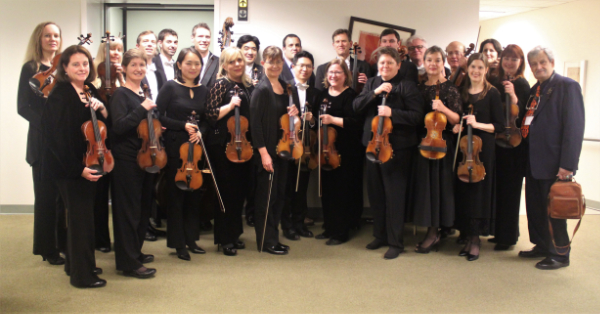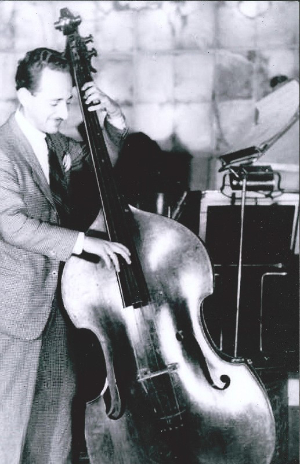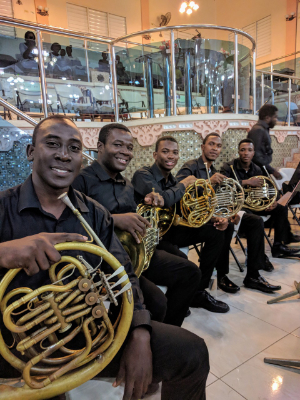Violins of Hope and Schindler’s List Too
The Violins of Hope project, which brought approximately 25 violins, a viola, and a cello to Nashville from mid-March to June 2, was nearly 27 months in the making. The instruments, collected and restored by father and son Amnon and Avshi Weinstein and played by Jewish musicians during the Holocaust, survived concentration camps, pogroms, and long journeys to tell their stories. The Nashville Symphony and the Jewish Federation and Foundation of Nashville and Middle Tennessee partnered with more than 25 arts organizations and sponsors to bring these instruments to Nashville and to facilitate a citywide dialogue about music, art, social justice, and free expression.
Even though customs delayed the instruments’ arrival until just before the first rehearsal of the Nashville Symphony’s classical series week, it didn’t dampen the musicians’ eagerness to choose an instrument for the week. While the Violins of Hope have been featured with other ICSOM orchestras—including Jacksonville (Note: See “Newslets” in the March 2017 issue), Charlotte, Alabama, and Cleveland—their residency in Nashville was the first in which the violins were to be featured in a recording project: Jonathan Leshnoff’s Symphony #4, “Heichelos”, for Naxos. In his opening remarks at the first performance, Mark Freedman, Executive Director of the Jewish Federation thanked Amnon and Avshi Weinstein for creating Violins of Hope and “serving as ambassadors of peace and understanding…and as trustees of a sacred heritage whose life’s work serves to turn the darkness and evil of the Holocaust toward a more promising and hopeful future filled with redemption and light…The sounds of the violins you will hear tonight are the transmission of musical blessings that could not be bestowed upon the vast generation that was lost to the Jewish people.” Referring to a poem he once wrote, Freedman said, “there are six million songs lost in the hills of Jerusalem. Tonight, in loving partnership with the Nashville Symphony, those six million songs have found a home among us to echo across this and future generations.”

Musicians of the Nashville Symphony with Avshi and Amnon Weinstein, the Rosner bass, and the Violins of Hope
Stephen Drake
Members of the Nashville Symphony used the instruments once more during the ten-week residency, for performances of Verdi’s Requiem. This work had been performed by the inmates at Theresienstadt concentration camp for the Red Cross to convince outsiders that Theresienstadt was a model resettlement village for European Jews. Rafael Schachter, who conducted the inmates’ performance, said the text gave the singers a chance to “sing to the Nazis what they could not say to them.”
That final weekend, the Jewish Federation presented violin #17 from the Weinsteins’ Violins of Hope collection to the NSO to commemorate their partnership.
The Nashville Ballet, Vanderbilt and Belmont Universities, numerous churches, temples, and community centers, along with the Nashville Public Library, held more than 56 performances, lectures/discussions, and events during the collection’s stay. Some performances included the use of a quartet of instruments from the Violins of Hope collection; the rest of the violins, along with remnants of damaged and weather-worn instruments, were displayed at the downtown Nashville Public Library free to the public—a first for the collection, according to presenters.
An additional element of the public dialogue were five other exhibits in Nashville—one each at Lane Motor Museum and Nashville State College, and three at the Frist Art Museum, including “Slavery, the Prison Industrial Complex: Photographs by Keith Calhoun and Chandra McCormick”—that explored issues of identity and social justice.

Leo Rosner
When word spread that the Violins of Hope were coming to Nashville, local musician Patrick Crossley was keenly interested, as he owns the bass that used to belong to Leo Rosner, one of the people saved as a result of having been on Schindler’s List. Rosner played the bass (thought to be a mid-19th century Tyrolean instrument) in the Krakow ghetto and was forced to play for Nazi officers and guests at the Płaszow labor camp. Schindler visited the family after the war, served as best man at the wedding of Rosner’s brother William (another name on the List), and facilitated the return of several instruments to the family after the war, including (likely) the bass.
Crossley, who moved to the Nashville area in the 1990s, heard about the Violins of Hope project and graciously lent the instrument to the bass section of the Nashville Symphony for the duration of the collection’s presence in Nashville. Members of the section were delighted to have this instrument on loan and especially honored to have the opportunity to play it. They offer their thanks to Patrick Crossley for his generous contribution to this important project.
An Update from Haiti
During the last week of March, a relief week, a group of Utah Symphony musicians visited Cap-Haïtien for the second annual Haitian National Orchestral Institute. This weeklong session of lessons, sectionals, rehearsals and concerts is the brainchild of two Utah Symphony musicians: violinist Yuki MacQueen and cellist John Eckstein (Note: See “A Week of Relief” in the December 2016 issue). Founded in 2017, the mission of the Institute is to foster the growth of orchestral music in Haiti while establishing bonds between the musicians of the Utah Symphony and the musicians of Haiti. The Institute is attended by musicians from all across Haiti who are selected by an audition process headed by Janet Anthony, recently retired Professor of Cello at Lawrence Conservatory of Appleton, Wisconsin and President of the BLUME-Haiti Foundation, a non-profit devoted to furthering the study of classical music in Haiti.

The horn section of the 2018 Haitian National Orchestral Institute
Stephen Proser
The students faced a grueling schedule: three hours of lessons and coaching in the mornings and three hours of orchestra rehearsals in the afternoon. The faculty gave a recital on the penultimate evening. The institute concluded with the big concert featuring the orchestra, led by Thierry Fischer, Music Director of the Utah Symphony, followed by a reception for the students and faculty.
Partnering with the Musicians of the Utah Symphony were Utah Symphony/Utah Opera and the BLUME-Haiti Foundation. This year they were joined by Utah Symphony/Utah Opera CEO Paul Meecham, as well as bassist Thomas Sperl of the Cleveland Orchestra and his wife, oboist Cynthia Sperl. The participants wish to extend thanks to Thierry Fischer for being with them from the beginning, and special thanks to the musicians of the Cleveland Orchestra, who made an extremely generous donation to the cause. Also, thanks to all of those that contributed their time, money, instruments, music, and accessories. They are looking forward to the third annual Haitian National Orchestral Institute, to be held in Jacmel, Haiti, during the first week of April, 2019.
New Ticket Paradigms
The Saint Paul Chamber Orchestra ended last year with record attendance—thanks partly to children and college kids who got in for free.
About 116,000 people attended at least one concert during the fiscal year that wrapped up June 30, 2017, a five percent increase over the year before. That number was boosted by the organization’s New Generation Initiative, launched last year, which offers school and college students free tickets.
Compared to the year before, young attendance quadrupled.
The orchestra announced its New Generation Initiative in August, 2016, a program designed to attract people under 40 to its productions. Children ages 6–17 and students of any age—from high schoolers to doctoral candidates with valid IDs—can order free tickets. SPCO subscribers also receive two free guest passes to give to anyone under 40.
Five individuals from the Twin Cities area, including members of the SPCO’s board of directors, donated about $200,000 to support the initiative.
The SPCO relies more on donations than ticket sales. In fiscal year 2017, 62.5% of the SPCO’s income came from contributions and other support. About 20.5% was “earned”. The endowment made up the rest.
The earned income category includes revenue from another SPCO initiative, the Concert Membership program. Started in 2012, this program allows attendance at an unlimited number of regular concerts for a monthly subscription cost, currently $7. Subscribers may obtain free seats in the second and third price tiers, subject to availability.
The annual report, presented in December, shows that the SPCO balanced its $10.3 million budget in fiscal year 2017, with a surplus of more than $340,000.
Minnesota’s New CEO
In April 2018, the Minnesota Orchestra announced the selection of its next President and CEO, Michelle Miller Burns, currently Executive Vice President for Institutional Advancement and Chief Operating Officer of the Dallas Symphony. The search process began nearly a year prior, with the formation of a committee comprising board members, musicians, and staff. The committee consisted of 15 voting members, with the Music Director and current President/CEO serving as advisors throughout the process. It was designed to be broadly inclusive of these three main constituent groups, with five committee members being musicians.
The committee began its search by identifying the main qualities desired in the next CEO, by looking at aspects of the organization in need of growth, and by engaging the executive search firm Isaacson, Miller to lead the search. The team from Isaacson then spent time in meetings with the committee, as well as members of the key constituent groups, to gain a deeper understanding of the institutional needs and to create a position profile. The confidential search process involved robust discussion, résumé and reference reviews, and several rounds of in-person interviews. Finalist candidates ultimately met separately with each search committee sub-group (musician, board, staff) for further in-depth interviews and then a full-committee social event.
Throughout the process, the musicians were heartened by the similarity of values and qualities that all members of the committee were seeking in the candidate selection. It was agreed early on by the group that they would continue to search for a new CEO until the decision was unanimous (which can be revealed now that the search is over and confidentiality restrictions are eased to a certain extent). This turned out to be the case with Michelle Miller Burns.
Her artistic values and depth of experience in the industry, combined with her collaborative leadership style, singled her out as the best candidate to lead the Minnesota Orchestra going forward. Ms. Miller Burns will accompany the orchestra on its August tour to London and South Africa, prior to her official start as CEO on September 1, 2018. The collaborative “Minnesota Model” served well in this important search, and the musicians are thrilled to have identified and engaged Ms. Miller Burns as the next CEO.
Texas Move ‘Em
The Fort Worth Symphony Orchestra announced in May that its Music Director, Miguel Harth-Bedoya, will step down from the post in 2020. “I believe that after a tenure of twenty seasons, it will be the right time for the orchestra to close a chapter and to begin a new one, exploring new challenges, points of view, opportunities and ideas,” Harth-Bedoya said.
Harth-Bedoya, the eighth Music Director in the orchestra’s 106-year history, has presided over tremendous change. Nearly two fifths of the current complement has joined since his first season, and the number of full-time positions has increased by 25%.
In neighboring Dallas, where DSO Music Director Jaap van Zweden just stepped down in May (Note: See “Newslets” in the March 2016 issue), the orchestra announced on June 4 that his successor will be Fabio Luisi, perhaps best known in this country as the former Principal Conductor of the Metropolitan Opera. Luisi currently holds three major conducting posts in Europe, including Principal Conductor of the Danish National Symphony Orchestra. He will become Music Director Designate for the 2019–2020 season, and assume the Music Director title the following season.
“I am delighted and proud to be appointed Music Director of the Dallas Symphony Orchestra,” said Luisi. “From the moment I met the orchestra again this spring, I felt a strong connection artistically and personally. These are supremely talented musicians, who welcomed me so warmly. Our performances were filled with great joy, and I look forward to working with them to share our mutual passion for this great music with audiences.”
Florida Sets a Path to Growth
On May 21, the musicians of the Florida Orchestra reached agreement with their management on a new collective bargaining agreement, months ahead of the expiration of the existing agreement. The terms of the three-year deal include a cumulative increase in the annual salary of 13.5%, achieved through a combination of weekly scale increases and the addition of two paid vacation weeks. Orchestra members have not had paid vacation since 2009. The complement will also grow to 68 musicians by the end of the agreement, an increase of two.
“This new agreement puts us on a path towards becoming a truly world class organization,” said Andrew Karr, the chair of the Orchestra Committee. “The musicians look forward to continuing to enrich the cultural life of the Tampa Bay region and representing it further afield.”






[…] Symphony No. 4, “Heichalos”, which featured the Violins of Hope (Note: see “Newslets” in the June 2018 issue). This category also included another nomination for Cincinnati (as the Cincinnati Pops Orchestra), […]